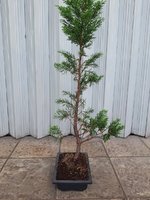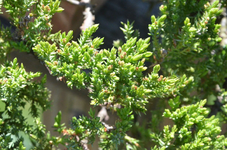Leo in N E Illinois
The Professor
- Messages
- 11,604
- Reaction score
- 24,251
- USDA Zone
- 5b
@Lumaca -
I'm with @Dav4 - you have a couple nice junipers.
@cheap_walmart_art - the OP is in Jakarta, equatorial tropics. Thuja is highly unlikely, as it needs a cold winter rest much more than Chamaecyparis, and Cupressus.
@Lumaca - I still think juniper is possible, but I did look at Wikipedia, for seed cones you showed look more like Cupressus (cypress) seed cones. Some of the North American cypress (more correctly Hesperocyparis) can be grown as tropical plants, as they come from areas that do not get cold in winter. For example Monterey cypress, Hesperocyparis macrocarpa, and Hesperocyparis pigmaea - the Mendocino cypress. Hesperocyparis goveniana - the California cypress or Gowen Cypress is pretty common in the ornamental and landscape industry. The empty cone you showed could be from any of these, and could be from Chamaecyparis. However, because Hesperocyparis goveniana is pretty common in horticulture, I would guess that it would be more likely than other Cypress. So Hesperocyparis or Chamaecyparis are possible. I do not know how well Chamaecyparis adapts to a tropical climate, but Hesperocyparis definitely does well in tropical environments.
Regardless, a prophylactic dose of Mancozeb will not hurt. Tip blight is common where temps are warm and humid. Even the coldest day in Jakarta would be considered warm and humid compared to the climates that both Hesperocyparis and Chamaecyparis and Juniperus would experience. So using a fungicide anytime this type of discoloration appears is probably a good idea.
I'm with @Dav4 - you have a couple nice junipers.
@cheap_walmart_art - the OP is in Jakarta, equatorial tropics. Thuja is highly unlikely, as it needs a cold winter rest much more than Chamaecyparis, and Cupressus.
@Lumaca - I still think juniper is possible, but I did look at Wikipedia, for seed cones you showed look more like Cupressus (cypress) seed cones. Some of the North American cypress (more correctly Hesperocyparis) can be grown as tropical plants, as they come from areas that do not get cold in winter. For example Monterey cypress, Hesperocyparis macrocarpa, and Hesperocyparis pigmaea - the Mendocino cypress. Hesperocyparis goveniana - the California cypress or Gowen Cypress is pretty common in the ornamental and landscape industry. The empty cone you showed could be from any of these, and could be from Chamaecyparis. However, because Hesperocyparis goveniana is pretty common in horticulture, I would guess that it would be more likely than other Cypress. So Hesperocyparis or Chamaecyparis are possible. I do not know how well Chamaecyparis adapts to a tropical climate, but Hesperocyparis definitely does well in tropical environments.
Regardless, a prophylactic dose of Mancozeb will not hurt. Tip blight is common where temps are warm and humid. Even the coldest day in Jakarta would be considered warm and humid compared to the climates that both Hesperocyparis and Chamaecyparis and Juniperus would experience. So using a fungicide anytime this type of discoloration appears is probably a good idea.



